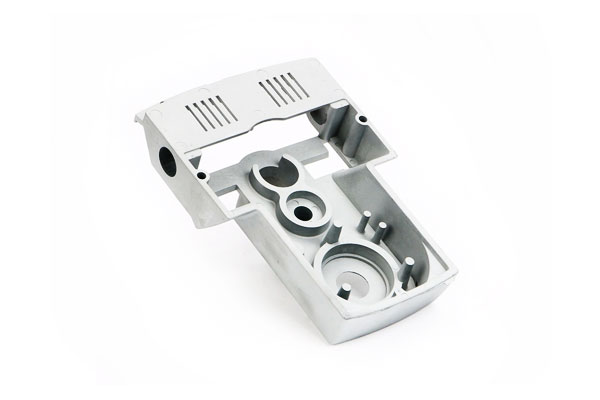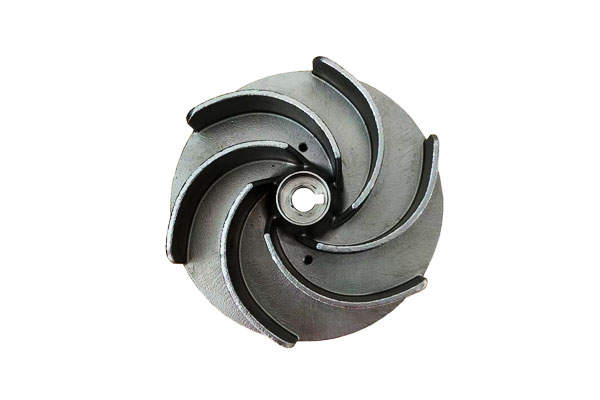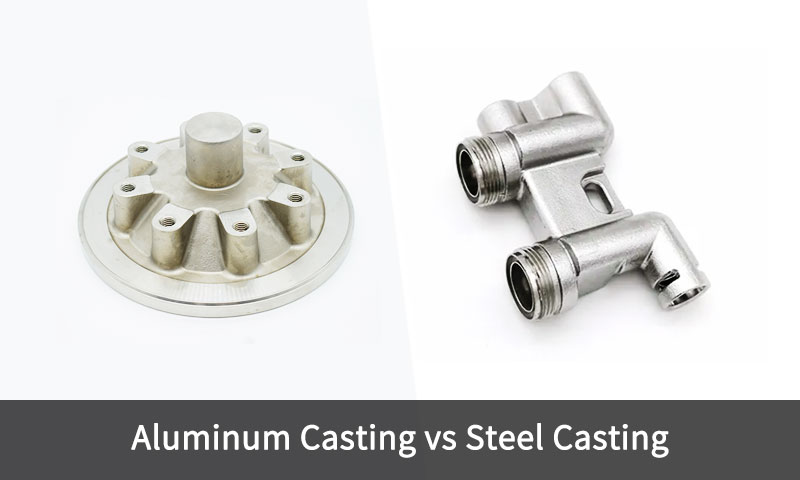1. Увођење
Aluminum vs Steel Casting — choosing between these two foundational materials shapes component performance, cost and manufacturability across industries from automotive to energy.
This comparison is not merely about metal chemistry: it encompasses density and stiffness, топлотно понашање, casting process compatibility, secondary processing (топлотни третман, површински инжењеринг), lifecycle cost and application-specific reliability.
Engineers and purchasers must therefore evaluate the entire system—loading, температура, environment, production volume and finish requirements—before specifying a metal and casting route.
2. Fundamental Material Differences Between Aluminum vs Steel
At the core of aluminum vs. steel casting lies a fundamental metallurgical and physical contrast that directly affects how each material behaves during casting, обрада, и сервис.
| Имовина | Алуминијум (Нпр., Ал-и улазни) | Челик (Нпр., carbon or low-alloy steels) | Инжењеринг импликација |
| Густина (Г / цм³) | 2.70 | 7.85 | Aluminum is ~65% lighter, offering major weight savings for transportation and aerospace. |
| Тачка топљења (° Ц) | 615-660 | 1425–1540 | Aluminum’s low melting point enables easier casting and lower energy consumption; steel requires specialized furnaces. |
| Топлотна проводљивост (В / м · к) | 120-180 | 40-60 | Aluminum dissipates heat efficiently—ideal for engines, Измењивачи топлоте, и електронике. |
| Специфична снага (MPa/ρ) | ~100–150 | ~70–90 | Despite lower absolute strength, aluminum’s strength-to-weight ratio surpasses that of steel. |
| Еластични модул (ГПА) | 70 | 200 | Steel is stiffer, providing better rigidity under load and vibration. |
Отпорност на корозију |
Одличан (forms Al₂O₃ layer) | Променљив; prone to rust without coatings | Aluminum resists oxidation naturally, while steel needs surface protection (сликање, овлашћење, or alloying with Cr/Ni). |
| Обрада | Одличан | Умерен до тешке | Aluminum’s softness allows easy machining and shorter cycle times; steel requires tougher tooling. |
| Рециклирање | >90% recoverable | >90% recoverable | Both materials are highly recyclable, though aluminum’s remelting requires less energy (5% of primary production). |
| Casting Shrinkage (%) | 1.3-1.6 | 2.0–2.6 | Steel shrinks more during solidification, demanding larger allowances and more complex gating/feeding systems. |
| Трошак (цца., USD/kg) | 2.0-3.0 | 0.8-1.5 | Aluminum is more expensive per kilogram, but savings in weight and processing can offset total lifecycle costs. |
3. What Is Aluminum Casting?
Алуминијум ливење is the process of shaping molten aluminum or aluminum alloys into complex, near-net-shape components using molds.
It is one of the most widely used metal casting processes globally—accounting for over 50% of all nonferrous castings—due to aluminum’s excellent castability, ниска густина, и отпорност на корозију.

Преглед
In aluminum casting, растопљени алуминијум (обично између 680–750°C) is poured or injected into a mold cavity where it solidifies into the desired geometry.
Aluminum’s low melting point and high fluidity make it ideal for both mass-production methods (like die casting) и Хигх-прецисион апликације (like investment casting).
Key Features of Aluminum Casting
- Лагана и висока омјер снаге:
Aluminum castings offer excellent mechanical performance while being about једна трећина тежина челика. - Добра отпорност на корозију:
Мршав, самоизлеђивање aluminum oxide layer (АЛ³О₃) protects against oxidation and most atmospheric or marine corrosion. - Одлична топлотна и електрична проводљивост:
Suitable for applications like Измењивачи топлоте, кућишта, and electric components. - Рециклирање:
Aluminum can be recycled indefinitely without degradation, reducing production energy by up to 95% compared to primary smelting.
Common Aluminum Casting Processes
| Метода ливења | Опис | Типичне апликације |
| Дие Цастинг | High-pressure injection of molten aluminum into steel dies; yields precise, Танки зидни делови. | Аутомобилски делови (кућишта зупчаника, заграде), Потрошачка електроника. |
| Ливење песка | Molten metal poured into sand molds; suitable for larger, lower-volume parts. | Блокови мотора, раздјелнике, кућишта за ваздухопловство. |
| Инвестиционо ливење | Ceramic molds from wax patterns; ideal for fine details and tight tolerances. | Компоненте за ваздухопловне турбине, Медицински уређаји. |
| Стално калупљење | Reusable metal molds; good surface finish and dimensional control. | Клипови, точкови, и морске компоненте. |
| Центрифугално ливење | Uses centrifugal force to distribute molten metal; густ, Структура без оштећења. | Цеви, рукаве, and rings. |
Предности ливења алуминијума
- Лагана: Reduces component weight by 30-50% вс. челик, improving fuel efficiency (аутомобилске) or payload capacity (ваздухопловство).
- Енергетска ефикасност: Melting aluminum requires 60–70% less energy than steel (570° Ц ВС. 1420° Ц), lowering processing costs by 20-30%.
- Отпорност на корозију: Eliminates the need for coatings (Нпр., сликати, поцинљив) У већини окружења, reducing maintenance costs by 40-50%.
- High-Volume Viability: Die casting enables production of 1000+ parts/day per machine, meeting consumer goods demand.
Disadvantages of Aluminum Casting
- Нижа снага: Затезна чврстоћа (150-400 МПА) is 50–70% lower than high-strength steel, limiting use in heavy-load applications.
- Poor High-Temperature Performance: Retains only 50% of room-temperature strength at 250°C, making it unsuitable for engine exhaust or power plant components.
- Ризик порозности: Die-cast aluminum is prone to gas porosity (from high-pressure injection), restricting heat treatment options (Нпр., T6 temper requires vacuum processing).
- Higher Raw Material Cost: Primary aluminum costs $2,500–$3,500/tonne, 2–3x more than carbon steel.
Industrial Applications of Aluminum Casting
Aluminum casting is widely used across multiple industries due to its combination of лаган дизајн, обрада, и отпорност на корозију:
- Аутомотиве: Блокови мотора, кућишта преноса, точкови, and suspension arms.
- Ваздухопловство: Заграде, структурни арматуре, Кућишта компресора.
- Електроника: Топлине, кућишта мотора, прилози.
- Роба широке потрошње: Уређаји, Алати за напајање, Хардвер намештаја.
- Marine and Renewable Energy: Пропелери, кућишта, и сечива турбине.
4. What Is Steel Casting?
Steel casting is the process of pouring molten steel into a mold to produce complex, high-strength components that cannot be easily fabricated or forged.
Unlike aluminum, steel has a Високо место топљења (≈ 1450–1530°C) and greater tensile strength, чинећи га идеалним load-bearing and high-temperature applications such as machinery, infrastructure, и генерација електричне енергије.

Преглед
In steel casting, carefully alloyed molten steel is poured into either expendable (песка, инвестиција) or permanent molds, where it solidifies into a shape close to the final part.
Because steel shrinks significantly upon cooling, precise temperature control, дизајн, and solidification modeling су критични.
Steel castings are known for their механичка робусност, отпорност на ударце, и структурни интегритет, particularly under harsh service conditions.
Key Features of Steel Casting
- Exceptional Strength and Toughness:
Yield strengths often exceed 350 МПА, with heat-treated alloys reaching over 1000 МПА. - High-Temperature Capability:
Retains strength and oxidation resistance up to 600–800°C, depending on composition. - Versatile Alloy Selection:
Includes Царбон Цлеел, Стеелс ниски легури, нехрђајући челичан, and high-manganese steels, each tailored for specific environments. - Заваривост и израда:
Cast steels can be post-processed effectively—machined, заварен, and heat-treated to enhance performance.
Common Steel Casting Processes
| Метода ливења | Опис | Типичне апликације |
| Ливење песка | Molten steel poured into bonded sand molds; Идеално за велике, сложени делови. | Тела вентила, кућишта пумпе, machinery housings. |
| Инвестиционо ливење | Ceramic molds formed from wax patterns; yields excellent accuracy and surface finish. | Младе за турбине, Хируршки алати, Аероспаце делови. |
| Центрифугално ливење | Rotational force distributes molten steel evenly; produces dense cylindrical components. | Цеви, линијски, носећи трке. |
| Ливење калупа за шкољке | Uses thin resin-coated sand molds; allows higher precision and smoother surfaces. | Мали делови мотора, заграде. |
| Непрекидно ливење | For semi-finished steel products like slabs and billets. | Raw material for rolling and forging. |
Advantages of Steel Casting
- Супериорна снага & Жилавост: Затезна чврстоћа (до 1500 МПА) и утицај на жилавости (40–100 J) make it irreplaceable for structural safety (Нпр., Компоненте моста, Аутомобилски шасија).
- Перформансе високог температуре: Operates reliably at 400-600 ° Ц (вс. aluminum’s 250°C limit), suitable for jet engine casings and power plant boilers.
- Low Raw Material Cost: Carbon steel costs $800–$1200/tonne, 60–70% less than primary aluminum.
- Отпорност на хабање: Heat-treated steel (Нпр., 4140) has surface hardness up to 500 Хб, reducing replacement frequency in abrasive applications by 50-70%.
Disadvantages of Steel Casting
- High Weight: Density 2.7x that of aluminum increases fuel consumption (аутомобилске) or structural load (зградама).
- High Energy Use: Melting steel requires 25–30 MWh/tonne (вс. 5–7 MWh/tonne for aluminum), increasing processing costs by 40-50%.
- Подложност корозије: Carbon steel rusts in moist environments (Стопа корозије: 0.5-1.0 мм / год in salt spray), requiring coatings (Нпр., поцинљив) that add $1.5–$2.5/kg to costs.
- Poor Machinability: Hardness requires specialized tools, Повећање времена обраде од стране 30-50% вс. алуминијум.
Industrial Applications of Steel Casting
Steel castings dominate industries demanding снага, издржљивост, и отпорност на топлоту:
- Изградња & Рударство: Excavator teeth, делови за дробљење, track links.
- Енергија & Генерација електричне енергије: Steam turbine casings, Тела вентила, нуклеарне компоненте.
- Уље & Гас: Drill heads, pipeline valves, раздјелнике.
- Транспорт: Train couplers, кућишта зупчаника, heavy-duty engine blocks.
- Ваздухопловство & Одбрана: Зупчаник, структурни арматуре, armor components.
5. Свеобухватно поређење: Aluminum vs Steel Casting
Process fit and part geometry
- Танки зидан, сложене, Делови са високим јачинама: aluminum die casting is optimal (ХПДЦ).
- Велики, тежак, load-bearing parts: steel/spheroidal graphite (Војвода) iron and cast steels via sand casting are preferred.
- Medium volume with high integrity requirements: low-pressure aluminum or investment casting steels depending on strength needs.
Mechanical performance & пост-обрада
- Топлотни третман: cast steel can be quenched & tempered to obtain high strength and toughness; aluminum alloys have age-hardening routes but reach lower maximum strengths.
- Surface engineering: aluminum readily anodizes; steel can be nitrided, carburized, induction hardened or coated with hard substances (керамика, тврди хромић).
Возачи трошкова (typical considerations)
- Material cost per kg: aluminum raw metal tends to be priced higher per kg than ferrous scrap/steel, but part mass reduces required amount.
- Алат за алате: die casting dies are expensive (high initial amortization) but low per-part cost at volumes >10k–100k; sand tooling is cheap but per-part labor higher.
- Обрада: aluminum machines faster (higher removal rates), lower tool wear; steel requires harder tooling and more machining time—raises total cost especially for small batches.
Доношење & defect modes
- Порозност: HPDC aluminum can develop gas and shrinkage porosity; permanent-mold and low-pressure reduce porosity.
Steel castings can suffer inclusions and segregation; controlled melting and post-HT reduce defects. - Димензионална контрола: die cast aluminum attains tight tolerances (± 0.1-0.3 мм); sand cast steel tolerances are looser (±0.5–2 mm) without post-machining.
Еколошки & life-cycle
- Рециклирање: both metals are highly recyclable. Recycled aluminum uses a small fraction (~5–10%) of the energy of primary smelting; recycled steel also has large energy savings compared to virgin iron.
- Use-phase: lightweight aluminum can reduce fuel consumption in vehicles — a system-level environmental benefit.
Сто: Aluminum vs Steel Casting — Key Technical Comparison
| Категорија | Ливење алуминијума | Челични ливење |
| Густина (Г / цм³) | ~2.70 | ~7.80 |
| Тачка топљења (° Ц / ° Ф) | 660° Ц / 1220° Ф | 1450–1530°C / 2640–2790°F |
| Снага (Затезан / Принос, МПА) | 130-350 / 70-250 (улога); до 500 Након топлоте | 400-1200 / 250-1000 (у зависности од оцене и топлоте) |
| Тврдоћа (Хб) | 30-120 | 120-400 |
| Еластични модул (ГПА) | 70 | 200 |
| Топлотна проводљивост (В / м · к) | 150-230 | 25-60 |
| Електрична проводљивост (% ИАЦС) | 35-60 | 3-10 |
| Отпорност на корозију | Одличан (природни оксидни слој) | Variable — requires alloying (ЦР, У, Мо) или премаз |
| Отпорност на оксидацију (High-Temp) | Ограничен (<250° Ц) | Добро до одлично (up to 800°C for some alloys) |
| Обрада | Одличан (мекан, easy to cut) | Умерено до лоше (теже, абразиван) |
| Капитаљивост (Флудност & Скупљање) | Висока флуидност, низак скупљање | Lower fluidity, higher shrinkage — needs precise gating |
| Предности тежине | ~65% lighter than steel | Heavy — suitable for structural loads |
Површинска завршна обрада |
Гладак, good detail reproduction | Rougher surfaces; may need machining or shot blasting |
| Heat Treatment Flexibility | Одличан (Т6, T7 tempers) | Широк (враголовање, гашење, ублажавање, нормализација) |
| Рециклирање | >90% recycled efficiently | >90% recyclable but requires higher remelting energy |
| Production Cost | Lower energy, Брже време циклуса | Higher melting cost and tool wear |
| Типичне толеранције (мм) | ±0.25 to ±0.5 (ливење); ±1.0 (ливење песка) | ±0.5–1.5 depending on process |
| Environmental Footprint | Низак (especially recycled aluminum) | Higher CO₂ and energy footprint due to high melting point |
| Типичне апликације | Аутомобилски точкови, кућишта, Аероспаце делови, роба широке потрошње | Вентили, турбине, Тешка машина, Структурне компоненте |
6. Закључак
Aluminum and steel castings solve different engineering problems.
Aluminum excels where лагана тежина, топлотна проводљивост, surface quality and high production rates matter.
Челик (and cast irons) dominate where велика снага, укоченост, отпорност на хабање, toughness and elevated temperature performance су потребни.
Good material selection balances functional requirements, трошак (total life cycle), producibility and finishing.
In many modern designs hybrid solutions appear (steel inserts in aluminum castings, clad or bimetallic components) to exploit the strengths of both metals.
Често постављана питања
Што је јачи: cast aluminum or cast steel?
Cast steel is significantly stronger—A216 WCB steel has a tensile strength of 485 МПА, 67% higher than A356-T6 aluminum (290 МПА).
Steel also has far greater toughness and wear resistance.
Can cast aluminum replace cast steel?
Only in applications where weight reduction is prioritized over strength (Нпр., automotive non-structural parts).
Steel is irreplaceable for high-load, high-temperature components (Нпр., кочиони турбина).
Which is more corrosion-resistant: cast aluminum or cast steel?
Cast aluminum is more corrosion-resistant in most environments (Стопа корозије <0.1 мм / год) вс. карбонски челик (0.5-1.0 мм / год).
Stainless steel castings match aluminum’s corrosion resistance but cost 2–3x more.
Which casting process is best for aluminum vs. челик?
Aluminum is ideal for die casting (висока количина) and sand casting (ниска цена).
Steel is best for sand casting (Велики делови) и улагање у инвестиција (сложене, high-tolerance components). Die casting is rarely used for steel.


